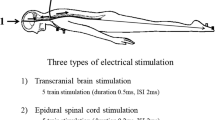Summary
Experiments were carried out on cats to determine the use of conductive evoked spinal cord action potentials in diagnosing motor function of the spinal cord. Direct stimulation from the dura produced three negative wave potentials, N1, N2 and N3. The intraspinal pathway of N2 and N3 was the dorsal column. The pathways of N1, determined by dorsal and ventral epidural recording, were the dorsilateral funicle and the extrapyramidal tracts. A collision experiment between potential N1 and pyramidal tract action potential did not reflect the function of the tract as the amplitude of the action potential was too small. Nevertheless, it is considered that conductive evoked spinal cord action potentials could become a valuable method of assessing spinal cord function as they reflect the function of the extrapyramidal tracts, as well as of the dorsilateral funicle and the dorsal column.
Résumé
Une expérimentation a été réalisée sur le chat afin d'évaluer si l'utilisation des potentiels évoqués d'action médullaire permet d'étudier la fonction motrice de la moelle épinière. La stimulation directe de la dure-mère produit trois ondes négatives: N1, N2 et N3. La voie intra-médullaire de N2 et de N3 est représentée par les cordons postérieurs. La voie de N1, déterminée par des enregistrements épiduraux antérieur, est le cordon postéro-latéral et le faisceau extra-pyramidal. Une étude couplée du potentiel N1 et de l'action du faisceau pyramidal ne reflète pas la fonction de ce faisceau car l'amplitude du potentiel d'action est trop faible. Néanmoins, on peut estimer que les potentiels évoqués d'action médullaire peuvent devenir une méthode valable d'examen de la fonction de la moelle épinière, puisqu'ils reflètent la fonction du faisceau extrapyramidal ainsi que celle des cordons postérieurs et postéro-latéraux.
Similar content being viewed by others
References
Ito M, Hongo T, Yoshida M, Obata K (1964) Antidromic and trans-synaptic activation of Deiter's neurons induced from the spinal cord. Jpn J Physiol 14:638–663
Peterson BW, Maunz RA, Pitts NG, Mackel R (1975) Patterns of projection and branching of reticulospinal neurons. Exp Brain Res 23:333–351
Satomi K, Okuma T, Kenmotsu K, Nakamura Y, Hirabayashi K (1988) Level diagnosis of cervical myelopathy using evoked spinal cord potentials. Spine 13:1217–1224
Shinomiya K, Furuya K, Sato R, Okamoto A, Kurosawa Y, Fuchioka M (1988) Electrophysiological diagnosis of cervical OPLL myelopathy using evoked spinal potentials. Spine 13:1225–1233
Tamaki T, Tsuji H, Inoue S, Kobayashi H (1981) The prevention of iatrogenic spinal cord injury utilizing the evoked spinal cord potential. Int Orthop 4:313–317
Tamaki L, Noguchi T, Takano H, Tsuji H, Nagawa T, Imai K, Inoue S (1984) Spinal cord monitoring as a clinical utilization of the spinal evoked potential. Clin Orthop 184:58–64
Author information
Authors and Affiliations
Additional information
This study was sponsored by a 1984 subsidy from the Orthopaedic Traumatology Study Foundation
Rights and permissions
About this article
Cite this article
Soeda, S., Satomi, K. & Hirabayashi, K. Experimental studies on spinal cord function using evoked action potentials. International Orthopaedics 14, 151–153 (1990). https://doi.org/10.1007/BF00180120
Issue Date:
DOI: https://doi.org/10.1007/BF00180120




